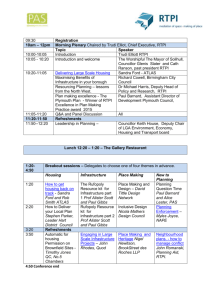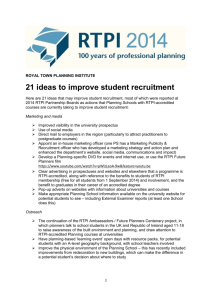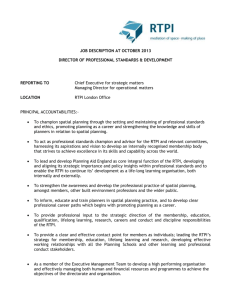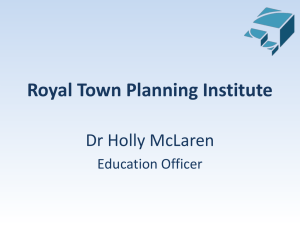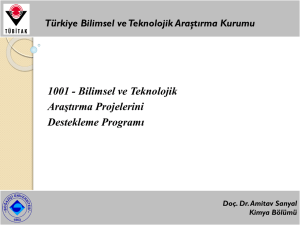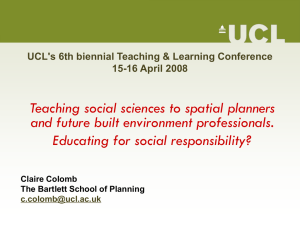Celebrating the idea of planning Please share
advertisement
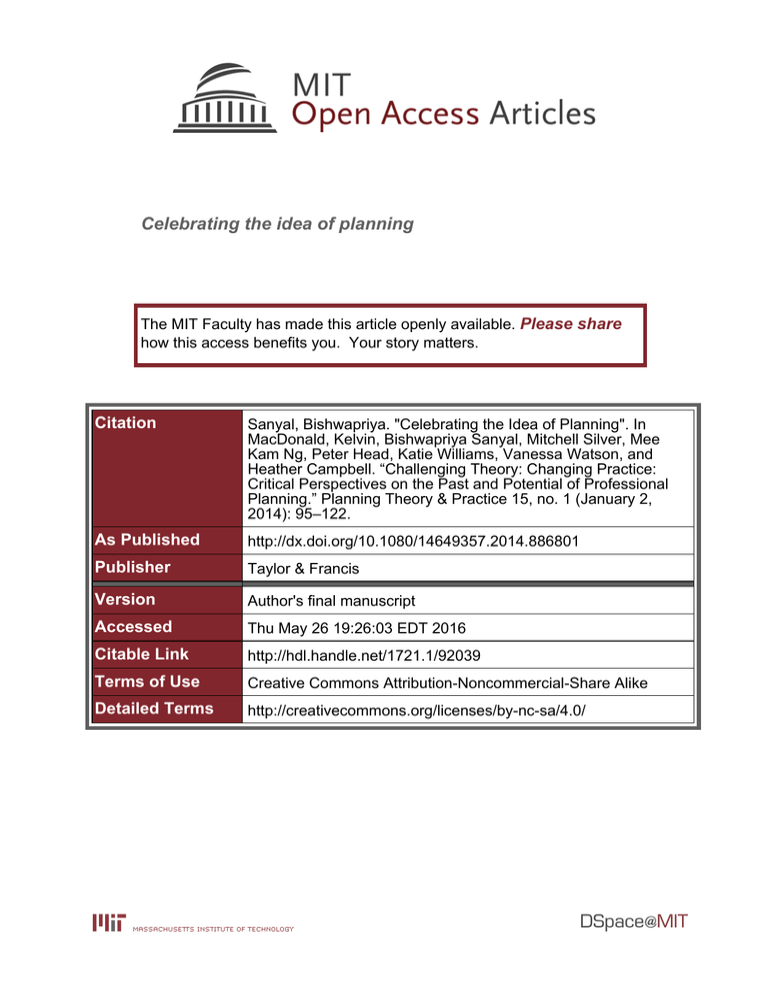
Celebrating the idea of planning The MIT Faculty has made this article openly available. Please share how this access benefits you. Your story matters. Citation Sanyal, Bishwapriya. "Celebrating the Idea of Planning". In MacDonald, Kelvin, Bishwapriya Sanyal, Mitchell Silver, Mee Kam Ng, Peter Head, Katie Williams, Vanessa Watson, and Heather Campbell. “Challenging Theory: Changing Practice: Critical Perspectives on the Past and Potential of Professional Planning.” Planning Theory & Practice 15, no. 1 (January 2, 2014): 95–122. As Published http://dx.doi.org/10.1080/14649357.2014.886801 Publisher Taylor & Francis Version Author's final manuscript Accessed Thu May 26 19:26:03 EDT 2016 Citable Link http://hdl.handle.net/1721.1/92039 Terms of Use Creative Commons Attribution-Noncommercial-Share Alike Detailed Terms http://creativecommons.org/licenses/by-nc-sa/4.0/ Bishwapriya Sanyal Celebrating the Idea of Planning Celebrating the idea of planning1 Bishwapriya Sanyal Department of Urban Studies and Planning, Massachusetts Institute of Technology, Cambridge, Massachusetts, USA The Royal Town Planning Institute (RTPI) should be proud that it was one of the first organizations to introduce the idea that good cities require public planning by qualified professionals. It is not that no one had thought of urban planning before; there are numerous examples, starting with the design of ancient cities in the Middle East and Asia, medieval cities in Europe, the restructuring of Paris by Napoleon, extensive planning of cities by Bismarck in Germany, planned cities in the UK, and even in the USA. When the RTPI was founded in 1914, there was significant accumulated knowledge that “the market” alone did not produce either majestic or well-functioning cities (Hall, 1998). Public interventions were necessary to produce cities that served as spatial nodes for the governing of emerging markets. What differentiated the creation of the RTPI in the early twentieth century was that “town planning” was now to be embedded within a democratic process, rather than being left to the whims of kings and queens. Its goal was not just to serve the needs of the royalty and the bourgeoisie, but the “emancipation of all communities.”1 To appreciate the significance of what the RTPI’s founding members were conveying by creating the new organization requires an awareness of that historical moment in 1914 – before World War I, before the Bolshevik Revolution, and before the Great Depression that led to massive state intervention and planning, now known as “Keynesianism”. Deeply aware of the adverse impact of capitalist industrialization and urbanization on the daily life of many citizens, the RTPI’s founding members had no illusions about the power of markets to improve the situation, but they had faith that if democratic institutions provided a forum for public deliberations, guided by expert knowledge of issues related to land use, land consolidation, and land taxation, then solutions could be found that would promote both capitalist industrialization and public well-being in the context of political democracy. Was the RTPI founded on contradictory ideas that hurt its effectiveness? Did its creation immobilize “naive planners” with fundamental “conundrums” they simply cannot resolve, as Kelvin MacDonald suggests? The evidence, now visible around the 1 Published in the Interface section of the RTPI Centenary edition of Planning Theory and Practice, entitled “Challenging theory: Changing practice: Critical perspectives on the past and potential of professional planning,” Planning Theory and Practice, 2014, Vol. 15, Issue 1, pp. 95-122. Available at: http://dx.doi.org/10.1080/14649357.2014.886801 1 Bishwapriya Sanyal Celebrating the Idea of Planning world thanks to increased interconnections in trade, communication, and flow of ideas and people, suggests the opposite. Though the RTPI did lose some of its original global grandeur with decolonization, most ex-colonies (including India, with which I am quite familiar) adopted RTPI-like societies with similar objectives: to create good cities through public planning based on expert knowledge of the structure and function of cities. Expert knowledge is necessary to craft strategic interventions that reap the benefits of market, state, and civil institutions–which collectively influence the quality of urban life. I acknowledge that there is often a mismatch between formal town planners’ aims and their effectiveness in controlling “the various beasts of ugliness,” as Kelvin MacDonald mentions in his introductory essay. But, I have yet to find a good city that has defeated such beasts of ugliness without planning of some kind. This is true at both the macro and micro levels: nations that have surged forward developmentally all relied on some form of planning (Rodrik, 2007) – not the same in content, but similar in their intentions – and that is equally true at the city level (Hall, 1988). The principles on which the RTPI was established have been vindicated not only in England and Europe, but also in formerly colonized nations. The question of whether professional planning societies have been effective was first raised at least 40 years ago, when most cities in newly industrializing nations faced rising unemployment, chronic housing and transportation shortages, and the concomitant rise of unauthorized and unplanned human settlements, which are yet to be incorporated in formal city plans. John Turner, who coined the term “self-help housing”, complained then that “governments have done so little with so much while people have done so much with so little!” (Turner, 1967). But even Turner acknowledged that some form of planning was necessary to tap the benefits of “selfhelp housing,” while regulating its adverse effects (Turner, 1979). Town planners around the world have been receptive to the kind of criticism that Turner initiated. Though their responses have varied, overall, formal planners have acknowledged that the old planning process that relied on master plans by architects and urban designers must evolve to address issues raised by unauthorized slums and informal employment, which continue to provide housing and livelihoods to a large number of urban residents in newly industrializing nations (Rodwin & Sanyal, 1987). What kinds of professional knowledge and expertise are necessary for urban planning practices, inspired by the RTPI, to meet the unprecedented urban challenges which have been well documented by a range of planning institutions from local to global levels? To meet such challenges, do cities and nations need more professional knowledge or less? This question too was first posed nearly 40 years ago – at a time when the value of traditional professional approaches was being questioned in city planning and in other fields as well (Schon, 1973). Such questioning did not lead to the end of professional planning; however, it did demonstrate the limits of traditional knowledge, it revealed the weaknesses of purely technocratic thinking, and in general, 2 Bishwapriya Sanyal Celebrating the Idea of Planning made professional planners relatively more open to public criticism – particularly in democratic societies (Hoffman, 1989). One aspect of the argument against traditional planning was that planning is not a purely technocratic exercise, but is inherently political in nature. Yet, John Dyckman has argued that just because planning must consider political realities does not mean that planning can be reduced to politics (Dyckman, 1986). How cities function and how land, labor, and commodities markets work and can be influenced by public policies, how technological changes affect the use of space by urban residents – such issues need to be understood both technically and in terms of their political implications. This, of course, is easier said than practiced by academic planners who teach in professional programs. The blending of technical knowledge and political astuteness requires a much more nuanced understanding of urban issues than that which RTPI members anticipated in 1914. It is a sign of intellectual strength, not weakness, for a professional body to acknowledge publicly the complexities of the challenges it faces – particularly for a profession that cares about underprivileged, marginalized and exploited groups, as RTPI clearly states in its 2001 public document (Royal Town Planning Institute, 2001). One can dismiss such statements as empty slogans by a professional body mired in philosophical conundrums, or as a planner, one can be proud that such a voice is among the many voices in democratic deliberations – particularly if it represents a thorough and nuanced understanding of why cities exist, grow, function and change, and, in the process, create opportunities and constraints that allow people to reach their full potential as human beings. My bias must be clear to the reader by now: I celebrate RTPI’s founding as one of the first institutions to profess the now well-vindicated idea that public planning is necessary for the creation of good cities. As we know, there have been many attempts to tarnish the ideals that motivated the idea (Sanyal, 1994), but even after a century of such attacks, the idea of planning as a form of public effort to “link knowledge with action” remains valid, not only in England but all across the world (Friedman, 1987). Note 1. The Right Honorable John Burns MP at the TPI inaugural dinner 30 January 1914. Bish Sanyal is a Ford International Professor of Urban Development and Planning and Director of the Special Program in Urban and Regional Studies (SPURS)/Humphrey Fellows Program at MIT. Professor Sanyal joined MIT in 1984, served as the Head of the Department of Urban Studies and Planning from 1994 to 2002 and was the Chair of the Faculty at MIT from 2007 to 2009. Professor Sanyal has degrees in Architecture and City Planning, and his interests include the interconnection between the developing world and the USA, and international planning education. 3 Bishwapriya Sanyal Celebrating the Idea of Planning References Dyckman, J. W. (1986). Planning practice in an age of reaction. In B. Checkoway (Ed.), Strategic perspectives on planning practice (pp. 11–24). Lexington, MA: Lexington Books. Friedman, J. (1987). Planning in the public domain: From knowledge to action. Princeton, NJ: Princeton University Press. Hall, P. (1988). Cities of tomorrow: An intellectual history of urban planning and design in the twentieth century. Oxford: Blackwell Publishing. Hall, P. (1998). Cities in civilization. New York, NY: Fromm International. Hoffman, L. (1989). The politics of knowledge: Activist movements in medicine and planning. New York, NY: SUNY Press. Rodrik, D. (2007). One economics many recipes: Globalization, institutions, and economic growth. Princeton, NJ: Princeton University Press. Rodwin, L., & Sanyal, B. (1987). Shelter, settlement and development: An overview. In L. Rodwin (Ed.), Shelter, settlement, and development (pp. 3–31). Boston, MA: Allen & Unwin. Royal Town Planning Institute. (2001). New vision for planning. Retrieved January 19, 2014 from http://www. rtpi.org.uk/education-and-careers/learning-about-planning/what-planning-does/rtpi-visionfor-planning Sanyal, B. (1994). From the benevolent to the evil state: History of the rise of antigovernment sentiment in developmental discourse. Cooperative autonomy: The dialectic of state—NGO relationship in developing countries (pp. 3–32). Geneva: International Institute for Labor Studies. Schon, D. (1973). Beyond the stable state. New York, NY: W.W. Norton & Company. Turner, J. C. (1967). Barriers and channels for housing development in modernizing countries. Journal of the American Institute of Planners, 33, 167–181. Turner, J. F. C. (1979). Housing in three dimensions: Terms of reference for the housing question redefined. In R. Bromley (Ed.), The urban informal sector: Critical perspectives on employment and housing policies (pp. 1135–1146). Oxford: Pergamon Press. 4
